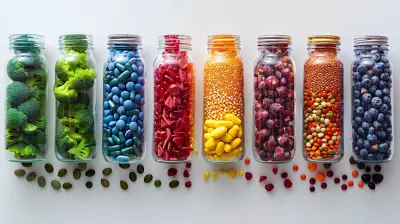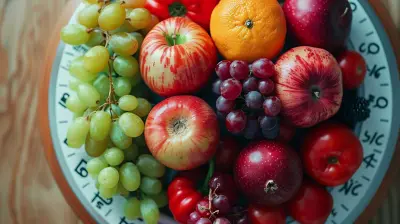How to Reduce Inflammation with Naturally Healing Foods
17 November 2025
Ever felt like your body’s been waving a big red flag, shouting “Hey, something’s not right here!”? That’s inflammation talking. And while a little bit of inflammation is your body’s natural way of healing, chronic inflammation? Yeah, that’s a whole other beast. It’s like leaving the lights on 24/7—eventually, the bulb’s gonna burn out.
But here’s the cool part: you’ve got serious control over how much inflammation is stirring around in your body, and it all starts with what you put on your plate.
Let’s dive into how to reduce inflammation with naturally healing foods. We’re talking pantry staples, supermarket faves, and a few underrated legends that can help calm the fire inside.
What Exactly Is Inflammation?
Before we start tossing turmeric into everything, let’s break this down. Inflammation is your body’s defense mechanism. Get a cut? Your immune system sends white blood cells to the scene, causing redness and swelling—that’s acute inflammation doing its job.Chronic inflammation, though? It’s sneaky. It’s low-level, long-term, and it’s linked to a laundry list of health problems: heart disease, arthritis, type 2 diabetes, Alzheimer’s, obesity…the list goes on. Think of it as a smoldering fire slowly damaging tissues and organs.
So what's fueling that fire? Well, lifestyle plays a big role—especially diet.
The Link Between Diet and Inflammation
Ever heard the phrase “food is medicine”? It sounds cliché, but it’s true. Certain foods send your body calming signals, while others light it up like a fireworks show.Here's the deal:
- Pro-inflammatory foods: Think sugar, refined carbs, processed meats, deep-fried foods, and artificially trans-fat-laden snacks. They mess with your metabolic health and poke the immune system.
- Anti-inflammatory foods: These are nutrient-rich, whole, mostly plant-based, and packed with antioxidants, healthy fats, and fiber. They’re the fire extinguishers your body loves.
Naturally Healing Foods That Help Reduce Inflammation
Ready to arm your body with inflammation-fighting goodness? Here’s your go-to grocery list.1. Fatty Fish: Omega-3 Powerhouses
Why they rock: Salmon, sardines, mackerel, and anchovies are high in omega-3 fatty acids—specifically EPA and DHA. These fats reduce inflammatory markers like CRP (C-reactive protein) and cytokines.How to eat it: Aim for fatty fish two to three times a week. Grill, bake, or toss it in a salad. Just skip the frying—that defeats the purpose!
Bonus: Not a fish fan? Walnuts, flaxseeds, chia seeds, and algae-based supplements are solid plant-based alternatives.
2. Berries: Tiny Fruits, Huge Benefits
Why they rock: Blueberries, strawberries, raspberries—they may be small, but they pack a punch. Loaded with antioxidants like anthocyanins, berries help neutralize inflammation-causing free radicals.How to eat it: Fresh, frozen, or blended into smoothies. Just watch out for added sugars in pre-packaged versions.
Ever hear the saying, “Eat the rainbow”? Berries are like the glitter of that rainbow.
3. Leafy Greens: Nature’s True Multivitamin
Why they rock: Kale, spinach, Swiss chard, and arugula contain fiber, folate, and vitamins A, C, and K—all essential for fighting inflammation.How to eat it: Salad base, smoothie filler, or sautéed in olive oil. Add a squeeze of lemon for extra detox support.
Think of leafy greens as a daily internal shower for your system.
4. Turmeric: The Golden Healer
Why it rocks: The active compound curcumin is a known inflammation slayer. It’s been used in traditional medicine for centuries.How to eat it: Add turmeric to soups, stews, rice, or even lattes. For better absorption, pair it with black pepper (which contains piperine) and a healthy fat.
Pro tip: Golden milk (turmeric + coconut milk + black pepper) is like a warm hug for your insides.
5. Extra Virgin Olive Oil: Liquid Gold
Why it rocks: Packed with oleocanthal and polyphenols, this oil mimics the effects of ibuprofen—minus the side effects.How to eat it: Drizzle over salads, cooked veggies, or use it as a dip for crusty whole-grain bread.
Think of olive oil as the WD-40 for your joints and arteries.
6. Nuts and Seeds: Crunchy Little Lifesavers
Why they rock: Almonds, walnuts, sunflower seeds, and flaxseeds are full of healthy fats, fiber, and protein—all inflammation fighters.How to eat it: Sprinkle on oatmeal or yogurt, toss into stir-fries, or just snack on a handful.
Watch the portions though—nuts are calorie-dense. A small handful goes a long way.
7. Green Tea: Sip Your Way to Wellness
Why it rocks: Green tea is rich in catechins, particularly EGCG, which inhibit inflammation at the cellular level.How to drink it: Replace that second cup of coffee with green tea. Add lemon or mint for extra flavor (and benefits!).
It’s like meditation in a mug.
8. Garlic and Ginger: The Dynamic Duo
Why they rock: Garlic contains sulfur compounds that block inflammatory pathways. Ginger, meanwhile, is loaded with gingerol—another potent anti-inflammatory.How to eat it: Fresh is best. Dice up garlic in sauces and soups. Grate ginger into stir-fry or tea.
These two punch way above their weight.
9. Whole Grains: Fuel with Fiber
Why they rock: Oats, quinoa, brown rice, and barley are high in fiber, which feeds the good gut bacteria and keeps inflammation down.How to eat it: Skip white bread and try overnight oats, quinoa bowls, or brown rice stir-fry.
Whole grains = long-lasting energy + low inflammation. Win-win.
10. Fermented Foods: Gut Health = Less Inflammation
Why they rock: Think yogurt, kefir, kimchi, sauerkraut, and miso. They’re teeming with probiotics, which help balance your gut microbiome—a key player in managing inflammation.How to eat it: Enjoy a spoonful of kimchi or sauerkraut with meals, swap sour cream for kefir, or go for unsweetened Greek yogurt.
Your gut is basically your second brain—treat it well.
What to Avoid if You're Fighting Inflammation
Okay, so we’ve talked about what to eat—but let’s also chat about the food villains in this story.🚫 Sugar
Refined sugar triggers insulin spikes, which in turn fuels inflammation. That means soda, candy, sweetened cereals—yeah, it’s time to cut way back.🚫 Refined Carbs
White bread, pastries, crackers…they break down quickly into sugar, feeding inflammation like gasoline on a flame.🚫 Processed Meats
Think: hot dogs, bacon, sausage. They're packed with preservatives and compounds that have been linked to increased inflammatory markers.🚫 Trans Fats
Found in many fried foods and packaged snacks. They do nothing but clog arteries and stoke inflammation.Lifestyle Tips to Support an Anti-Inflammatory Diet
Food is a huge piece of the puzzle, but let’s not pretend it’s everything. Here are a few more ways to show inflammation the exit:- Get moving: Regular exercise (just 30 minutes a day) helps reduce inflammation and boost immunity.
- Sleep better: Aim for 7–9 hours. Poor sleep increases inflammatory markers like CRP.
- Manage stress: Chronic stress = chronic inflammation. Try journaling, yoga, deep breathing, or just a long walk.
- Stay hydrated: Water helps flush out toxins and keep your cells running efficiently.
Sample One-Day Anti-Inflammatory Meal Plan
Need a little inspiration? Here’s what a day of anti-inflammatory eating could look like:Breakfast: Overnight oats with chia seeds, blueberries, walnuts, and a drizzle of honey.
Snack: Green tea + apple slices with almond butter.
Lunch: Quinoa bowl with kale, grilled salmon, cherry tomatoes, and olive oil vinaigrette.
Snack: Greek yogurt with cinnamon and fresh strawberries.
Dinner: Stir-fried broccoli, mushrooms, ginger, and tofu over brown rice with a side of kimchi.
Dessert: Turmeric ginger tea and a square of dark chocolate (70% or higher).
Final Thoughts
Reducing inflammation isn’t about perfection—it’s about progress. You don’t need to go full-on vegan or toss out your entire pantry overnight. Start small. Maybe it’s swapping refined grains for whole grains. Or trading soda for green tea. Little changes add up in a big way.Remember: your food choices either feed disease or fight it. And you have the power—in fact, the fork—to decide.
So go ahead, spice it up with turmeric, load up on berries, and give your gut some probiotic love. Your body will thank you with more energy, less pain, and better long-term health.
all images in this post were generated using AI tools
Category:
WellnessAuthor:

Angelo McGillivray
Discussion
rate this article
1 comments
Zeno Horne
Thank you for sharing such valuable insights on reducing inflammation through natural foods. I appreciate the practical tips and the focus on simple, accessible ingredients. It’s inspiring to learn how we can make positive changes in our diet for better health. Looking forward to trying some of these suggestions!
November 17, 2025 at 4:04 AM


